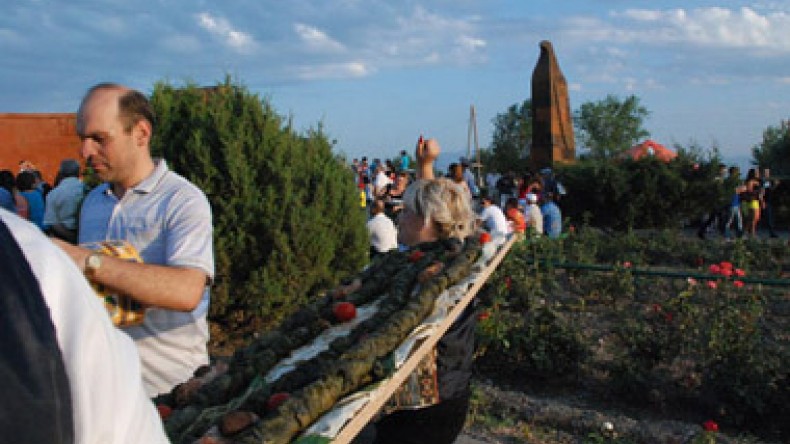
It’s a dolma thing
Taste-Testers flocked through the flanked winged oxen of the Sardarabad memorial for the third annual Dolma Festival on Wednesday, July 10. Traditional music, singing, and dancing set the mood for the festival as 24 groups locked in a battle of vine leaves and stuffing for prizes in a number of categories including the longest Dolma, says an article in Asbarez.
The festival was organized by the Armenian Cookery Traditions Development and Protection Organization (ACTDP) and exposed visitors to a number of variations of the traditional Armenian dish. Qajik Levonyan, a representative of the Araratian Restaurant , said that the name of the three thousand-year-old dish stems from the Armenian word Dol, which means vine leaves, and that the recipe’s secret lies in the freshness of the ingredients.
Contestants were either representatives of restaurants or organizations. Members of the International Women’s Association in Yerevan (IWAY) were also rolling vine leaves at the festival and had a number of styles of the dish including Romanian and Syrian.
Myrna Mugrditchian-Tcheler, President of IWAY, says that the festival is a great way to promote the group’s mission to the public and introduce Armenian culture to its international members while offering something in return to Armenia.
United States Ambassador to Armenia John Heffern was seen at the contestants’ stalls, tasting the variations of the Armenian delicacy. He says he is a frequent visitor to such festivals and hopes to promote the specialties of the many Armenian “micro-communities.” Heffern says he is an avid dolma fan and thinks this festival is important in showcasing one of the important aspects of Armenian culture.
A panel of five judges decided who walked away with the most prestigious titles in the Armenian culinary arts, including best tasting dolma. Judge Garen Komendaryan says that it is important to have a number of judges since food tasting is a subjective opinion. The festival, he says, is important in preserving and promoting the traditions in Armenian culinary arts “because without that we are not a nation.” Mugrditchian-Tcheler, who is also a judge at the festival, says the appearance, decoration, taste and originality are all taken into consideration when deciding on a winning dolma.
Adel Nehmeh, a Lebanese national and visitor to the festival, says he came to Armenia with his mother to reconnect with his Armenian heritage and was pleasantly surprised at the grandeur of the dolma festival. The traditional dancing, singing, and music present at the festival all promoted a celebratory atmosphere in the venue and was great exposure for the vibrancy of the Armenian culture. The venue, Nehmeh says, was of particular interest to him as it showcased the gravity and pride of the Sardarabad battle.
However, not all were impressed by the dolma presented at the festival. American-Armenian David Nazarian says he admires the social aspect of such Armenian traditions, but didn’t think there were “too many top-contenders at the festival.” Nazarian says, while incessantly slicing the vine wraps on his Styrofoam plate with a plastic fork and speaking with a mouthful, that he has had better dolma at home and at family gatherings. He says the dolma presented at the festival is “commercial” and is not a true representative of what the dish stands for.
Head Chef and President of the Armenian Cookery Organization, Setrag Mamoulian, took to the stage, as the sun began to set behind the 85-foot tall bell tower, to announce the winners of the festival. Backed with song and dance, a 25-foot dolma tray was held up at the venue’s stage by its makers, and the winner of the “longest dolma” contest, Garine Restaurant.
IWAY walked away with the honorary title of best tasting dolma, while Araratian Restaurant’s version was awarded for best presentation. The judges crowned the chefs from Arvasar Restaurant as the festival’s winners. The day ended with stomachs full of dolma and the exhaustion attributed to a festal Armenian gathering.
Newsfeed
Videos






























